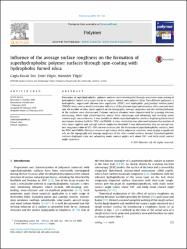Influence of the average surface roughness on the formation of superhydrophobic polymer surfaces through layer-by-layer spin-coating with hydrophobic fumed silica
Citation
Koşak Söz, Ç., Yılgör, E., & Yılgör, İ. (2015). Influence of the average surface roughness on the formation of superhydrophobic polymer surfaces through spin-coating with hydrophobic fumed silica. Polymer, 62, 118-128.Abstract
Formation of superhydrophobic polymer surfaces were investigated through successive spin-coating of hydrophobic fumed silica dispersed in an organic solvent onto polymer films. Two different polymers, a hydrophobic segmented silicone-urea copolymer (TPSC) and hydrophilic poly(methyl methacrylate) (PMMA) were used as model substrates. Influence of the polymer type and structure, silica concentration and the number of silica layers applied on the topography, average roughness and the wetting behavior of the surfaces were determined. Polymer surfaces obtained were characterized by scanning electron microscopy, white light interferometry, atomic force microscopy and advancing and receding water contact angle measurements. It was possible to obtain superhydrophobic surfaces displaying hierarchical micro/nano features both for TPSC and PMMA. A close correlation was observed between the number of silica layers applied and average surface roughness obtained. It was demonstrated that an average surface roughness value of 125–150 nm was necessary for the formation of superhydrophobic surfaces, both for TPSC and PMMA. Chemical structure and nature of the polymeric substrate seem to play a significant role on the topography and average roughness of the silica coated surfaces formed. Superhydrophobic surfaces displayed static and advancing water contact angles well above 150° and fairly small contact angle hysteresis.

















